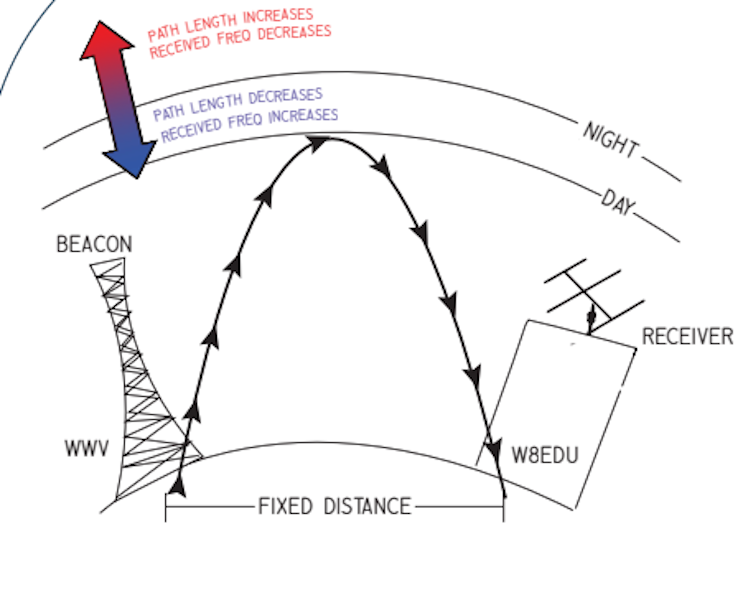A solar eclipse is coming up in just a few weeks, and although with its path of totality near the southern tip of South America means that not many people will be able to see it first-hand, there is an opportunity to get involved with it even at an extreme distance. PhD candidate [Kristina] and the organization HamSCI are trying to learn a little bit more about the effects of an eclipse on radio communications, and all that is required to help is a receiver capable of listening in the 10 MHz range during the time of the eclipse.
It’s well-known that certain radio waves can propagate further depending on the time of day due to changes in many factors such as the state of the ionosphere and the amount of solar activity. What is not known is specifically how the paths can vary over the course of the day. During the eclipse the sun’s interference is minimized, and its impact can be more directly measured in a more controlled experiment. By tuning into particular time stations and recording data during the eclipse, it’s possible to see how exactly the eclipse impacts propagation of these signals. [Kristina] hopes to take all of the data gathered during the event to observe the doppler effect that is expected to occur.
The project requires a large amount of volunteers to listen in to the time stations during the eclipse (even if it is not visible to them) and there are only a few more days before this eclipse happens. If you have the required hardware, which is essentially just a receiver capable of receiving upper-sideband signals in 10 MHz range, it may be worthwhile to give this a shot. If not, there may be some time to cobble together an SDR that can listen in (even an RTL-SDR set up for 10 MHz will work) provided you can use it to record the required samples. It’s definitely a time that ham radio could embrace the hacker community.
















” (even an RTL-SDR set up for 10 MHz will work) ”
A standard RTL-SDR won’t go down to 10MHz.
There are techniques that will extent the range – eg. an up-converter can be used for HF
That’s why you have to “set it up”.
a standard RTL-SDR will go down to 10 MHz, it will go down to a few hundred kHz with direct sampling
I enjoyed when we did the SEQP and associated activities for the Great American Eclipse. Had my FlexRadio running full tilt. 73, N2RJ
Brooke Allen N2BA & I operated from Boise, ID during the last big US eclipse. He was in a park about 5 miles from his cousin’s house where I operated. Great fun! A young researcher at Stevens Hoboken Institute of Technology was the principal investigator. 73 DE N2GJ
So, we tune in to WWV[H] at 10MHz during the eclipse and see if we can hear it?
You record signals at 10MHz using audacity. There are some South American standard time and frequency signals there. Even though WWV/WWVH is on that frequency, you can still faintly hear others. They’re trying to determine the effect on frequency. I have a GPSDO (GPS disciplined oscillator, basically means the frequency in my radio is locked to GPS) in my SDR so I’ll be using that.
Seems like this is a job for WSPR?
Not at all. The receivers aren’t talking, they’re listening. The task isn’t just to hear WWV/WWVH/$time_standards_station, it’s to detect phase changes, which boils down to detecting frequency changes. Since WWV and WWVH (and similar stations in other countries) are hooked up to atomic clocks, they broadcast with incredible accuracy and stability in terms of frequency, so if you have a receiver that *also* has good accuracy and stability (usually with the help of a GPSDO (GPS Disciplined Oscillator), which is hooked up to a bunch of atomic clocks in space), any frequency deviations you measure with the receiver are coming from something else. In this case, the something-else is mostly just the ionosphere – as the ionosphere changes, the RF propagation path lengthens and shortens, and you can actually hear the Doppler effect (well, your instruments can). If you get enough receivers listening, you can make a pretty nice map of the ionosphere as the shadow of the moon cuts through it.
Now, if you can convince WSPR users to integrate GPSDOs into their rigs and publish the exact frequencies they’re transmitting/listening on (and the I/Q data for what they send/receive) in a way that works for the scientists (who have Requirements), you might be able to get something out of it. Of course, there very well might be other considerations, as WSPR really isn’t very much like AM. For instance, measuring the frequency of something that doesn’t have a carrier is a bit trickier. You might want to hop on the HamSCI mailing list and bring it up – as far as I know, someone might already be thinking about or working on it.
Indeed, some of the HamSCI folks have done work on using existing ham radio networks for ionospheric sensing: https://agupubs.onlinelibrary.wiley.com/doi/full/10.1029/2018GL077324
Looking at WSPR and RBN data is on the list for this eclipse, but it’s a different set of measurements.
I’m game.
I have a 857 linked to a AMD embedded computer using a 6BTV antenna.
I just need to know start, stop, what format to save in, what information is needed and where to submit.
Ha, nevermind, just found the link.
I’m not used to how Hack-a-day posts stuff